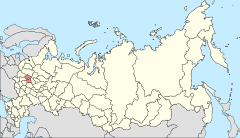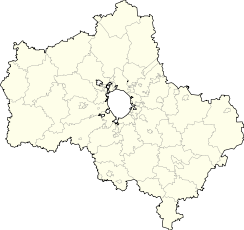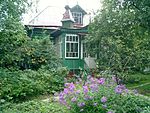- Malakhovka, Moscow Oblast
-
Malakhovka (English)
Малаховка (Russian)- Urban-type settlement[1] -
Work settlement[1]
Location of Moscow Oblast in RussiaCoordinates: 55°38′37″N 38°00′32″E / 55.64361°N 38.00889°ECoordinates: 55°38′37″N 38°00′32″E / 55.64361°N 38.00889°E Coat of arms of Malakhovka Flag of Malakhovka Anthem Anthem of Malakhovka[2] Administrative status (as of March 2010) Country Russia Federal subject Moscow Oblast[1] Administrative district Lyuberetsky District[1] Municipal status (as of June 2009) Municipal district Lyuberetsky Municipal District[3] Urban settlement Malakhovka Urban Settlement[3] Administrative center of Malakhovka Urban Settlement[3] Head[4] Alexander Avtayev[citation needed] Representative body Council of Deputies[5] Statistics Population (2010 Census,
preliminary)23,991 inhabitants[6] Population (2002 Census) 18,552 inhabitants[7]
pop_density=Time zone MSD (UTC+04:00)[8] First mentioned 1328[citation needed] Urban-type settlement status since 1961[9] Postal code(s) 140030[citation needed] Official website Malakhovka (Russian: Мала́ховка), a Moscow suburb with historic dachas,[10] is an urban locality (a work settlement) in Lyuberetsky District of Moscow Oblast, Russia.[1] Population: 23,991 (2010 Census preliminary results);[6] 18,552 (2002 Census);[7] 26,454 (1989 Census).[11]
Municipally, Malakhovka is incorporated as an urban settlement which, apart from Malakhovka proper, also has jurisdiction over the smaller village of Pekhorka and adjacent territories.[3]
Under the name Malakhovskoye (Мала́ховское), it was first mentioned in 1328 in Ivan Kalita's will as a place left to Ivan's older son Semyon.
The railway station was built in 1884, and by the next year Malakhovka was recognized as a dacha settlement. By the end of the 19th century, the settlement was inhabited by such renowned representatives of Russian arts and literature as Anton Chekhov, Maxim Gorky, Ivan Bunin, and Feodor Chaliapin.[10] Chaliapin performed in the Summer Theatre before 1914.[12] The actress Faina Ranevskaya performed there from the following year, and also had a dacha there. At the time of the Revolution Malakhovka was a “hamlet” of about three hundred dachas.[12]
Marc Chagall taught at a Jewish boys shelter (mainly for refugees from Ukrainian pogroms) here in 1921, did the illustrations for David Hofstein's long poem "Troyer" (Grief) and worked on his mural "Introduction to the Jewish Theater".[13] The refuge was a center for many Yiddish writers including Der Nister, who lived with Chagall, David Hofstein, and Itzik Feffer.[14]
The Soviet writer and USSR State Prize Laureate Nikolay Dobronravov (husband of Aleksandra Pakhmutova) went to school in Malakhovka during the war.[15] The Olympic and World champion runner Irina Privalova was born in Malakhovka.
An early (1959) poem by Andrey Voznesensky is "Last Train to Malakhovka", regarding his regular trips to the settlement.[16] The Malakhovka railway station is located 29 kilometers (18 mi) southeast from Moscow. The settlement has minor industry, two sanatoriums, a history museum, an Orthodox Church, a Synagogue, and old dachas.
Malakhovka has a local newspaper, Malakhovsky Vestnik (Мала́ховский Ве́стник, "Malakhovka Herald").
References
Notes
- ^ a b c d e Resolution #10-PG
- ^ Charter of Malakhovka, Article 1.4
- ^ a b c d Law #81/2005-OZ, Article 1.4
- ^ Charter of Malakhovka Urban Settlement, Article 13.1.2
- ^ Charter of Malakhovka Urban Settlement, Article 13.1.1
- ^ a b Федеральная служба государственной статистики (Federal State Statistics Service) (2011). "Предварительные итоги Всероссийской переписи населения 2010 года (Preliminary results of the 2010 All-Russian Population Census)" (in Russian). Всероссийская перепись населения 2010 года (All-Russia Population Census of 2010). Federal State Statistics Service. http://www.perepis-2010.ru/results_of_the_census/results-inform.php. Retrieved 2011-04-25.
- ^ a b Федеральная служба государственной статистики (Federal State Statistics Service) (2004-05-21). "Численность населения России, субъектов Российской Федерации в составе федеральных округов, районов, городских поселений, сельских населённых пунктов – районных центров и сельских населённых пунктов с населением 3 тысячи и более человек (Population of Russia, its federal districts, federal subjects, districts, urban localities, rural localities—administrative centers, and rural localities with population of over 3,000)" (in Russian). Всероссийская перепись населения 2002 года (All-Russia Population Census of 2002). Federal State Statistics Service. http://www.perepis2002.ru/ct/doc/1_TOM_01_04.xls. Retrieved 2010-03-23.
- ^ Правительство Российской Федерации. Постановление №725 от 31 августа 2011 г. «О составе территорий, образующих каждую часовую зону, и порядке исчисления времени в часовых зонах, а также о признании утратившими силу отдельных Постановлений Правительства Российской Федерации». Вступил в силу по истечении 7 дней после дня официального опубликования. Опубликован: "Российская Газета", №197, 6 сентября 2011 г. (Government of the Russian Federation. Resolution #725 of August 31, 2011 On the Composition of the Territories Included into Each Time Zone and on the Procedures of Timekeeping in the Time Zones, as Well as on Abrogation of Several Resolutions of the Government of the Russian Federation. Effective as of after 7 days following the day of the official publication).
- ^ Администрация Московской области. Организационно-контрольное управление (1999). Справочник по административно-территориальному устройству Московской области. Москва: ГУП ИПК "Ульяновский Дом печати". p. 14.
- ^ a b Toda, Yasushi and Nozdrina, Nadezhda N.(2008) The Cottages in Suburban Moscow: A New Lifestyle for the Wealthy, Journal of Communist Studies and Transition Politics, 24: 3, 444—455
- ^ "Всесоюзная перепись населения 1989 г. Численность наличного населения союзных и автономных республик, автономных областей и округов, краёв, областей, районов, городских поселений и сёл-райцентров. (All Union Population Census of 1989. Present population of union and autonomous republics, autonomous oblasts and okrugs, krais, oblasts, districts, urban settlements, and villages serving as district administrative centers.)" (in Russian). Всесоюзная перепись населения 1989 года (All-Union Population Census of 1989). Demoscope Weekly (website of the Institute of Demographics of the State University—Higher School of Economics. 1989. http://demoscope.ru/weekly/ssp/rus89_reg.php. Retrieved 2010-03-23.
- ^ a b Timothy J. Colton (1998), Moscow: Governing the Socialist Metropolis, Harvard University Press, page 127.
- ^ Harshav, Benjamin. 2004. Marc Chagall and His Times, Stanford University Press. Pages 75, 294, 298.
- ^ Dara Horn, The World to Come, W.W. Norton, 2006, page 313.
- ^ Persona.rin.ru. Nikolai Dobronravov
- ^ Andrey Voznesensky, Antiworlds and The Fifth Ace, Basic Books, New York 1967, pp 84-87.
Sources
- Toda, Yasushi and Nozdrina, Nadezhda N. (2008) The Cottages in Suburban Moscow: A New Lifestyle for the Wealthy, Journal of Communist Studies and Transition Politics, 24: 3, 444—455
- Timothy J. Colton (1998) Moscow: Governing the Socialist Metropolis, Harvard University Press, 1998, page 127.
- Совет депутатов городского поселения Малаховка. Решение №259/37 от 23 октября 2008 г. «Устав городского поселения Малаховка Люберецкого муниципального района Московской области», в ред. Решения №323/49 от 29 сентября 2009 г «О принятии положения городского поселения Малаховка о поправках к Уставу городского поселения Малаховка». Вступил в силу со дня, следующего за днём официального опубликования. Опубликован: "Малаховский вестник", №49–50, 26 декабря 2008 г. (Council of Deputies of Malakhovka Urban Settlement. Decision #259/37 of October 23, 2008 Charter of Malakhovka Urban Settlement of Lyuberetsky Municipal District of Moscow Oblast, as amended by the Decision #323/49 of September 29, 2009 On Adopting the Provision of Malakhovka Urban Settlement on Amending the Charter of Malakhovka Urban Settlement. Effective as of the day following the day of the official publication).
- Губернатор Московской области. Постановление №10-ПГ от 29 января 2007 г. «Об учётных данных административно-территориальных и территориальных единиц Московской области», в ред. Постановления №134-ПГ от 22 сентября 2009 г «О внесении изменений в Постановление губернатора Московской области от 29.01.2007 №10-ПГ "Об учётных данных административно-территориальных и территориальных единиц Московской области"». Опубликован: "Информационный вестник Правительства МО", №3, 26 марта 2007 г. (Governor of Moscow Oblast. Resolution #10-PG of January 29, 2007 On the Inventory Data of the Administrative-Territorial and Territorial Units of Moscow Oblast, as amended by the Resolution #134-PG of September 22, 2009 On Amending the Resolution #10-PG of the Governor of Moscow Oblast of January 29, 2007 "On the Inventory Data of the Administrative-Territorial and Territorial Units of Moscow Oblast". ).
- Московская областная Дума. Закон №81/2005-ОЗ от 28 февраля 2005 г. «О статусе и границах Люберецкого муниципального района, вновь образованного в его составе городского поселения и существующих на территории Люберецкого района Московской области муниципальных образований», в ред. Закона №65/2009-ОЗ от 5 июня 2009 г «О внесении изменений в Закон Московской области "О статусе и границе городского округа Лыткарино" и Закон Московской области "О статусе и границах Люберецкого муниципального района, вновь образованного в его составе городского поселения и существующих на территории Люберецкого района Московской области муниципальных образований"». Вступил в силу со дня официального опубликования. Опубликован: "Ежедневные Новости. Подмосковье", №44, 12 марта 2005 г. (Moscow Oblast Duma. Law #81/2005-OZ of February 28, 2005 On the Status and the Borders of Lyuberetsky Municipal District, the Newly Established Urban Settlement It Comprises, and the Existing Municipal Formations on the Territory of Lyuberetsky District of Moscow Oblast, as amended by the Law #65/2009-OZ of June 5, 2009 On Amending the Law of Moscow Oblast "On the Status and the Border of Lytkarino Urban Okrug" and the Law of Moscow Oblast "On the Status and the Borders of Lyuberetsky Municipal District, the Newly Established Urban Settlement It Comprises, and the Existing Municipal Formations on the Territory of Lyuberetsky District of Moscow Oblast". Effective as of the day of the official publication).
Categories:- Urban-type settlements in Moscow Oblast
Wikimedia Foundation. 2010.




